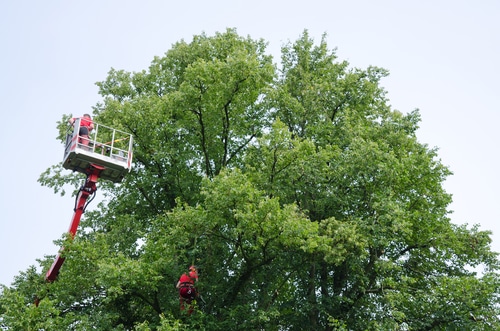Contents show
Ideal Planting Locations for Young Mesquite Trees
Are you thinking about planting a mesquite tree on your residential or commercial property? One of the most important considerations is this tree’s root system. Mesquite trees are known for having a large, extensive root system. This is what enables the tree to thrive in arid conditions. Unfortunately, many homeowners plant these trees too close to sewer lines, pools, and hardscaping features. The roots can grow into sewer lines or other features, potentially causing significant damage. This is one reason why it’s best to seek professional guidance from a landscaping company before planting a mesquite tree.
Aside from being located far away from pipes and other installations, the most important considerations when planting a mesquite tree are the soil and sun exposure. The location should have well-draining soil. Mesquite trees can tolerate a range of soil types, although particularly sandy soil may require some soil amendments. A mesquite tree will prefer an area that receives a great deal of sunlight.
Your Mesquite Tree’s Water Requirements
If you have only recently planted your mesquite tree, you’ll need to water it more than you otherwise would. Keep the soil moist for the first two months. At that point, the tree should have established its feeder roots. Under normal conditions, mesquite trees require little to no supplemental water, as they are well-adapted to living in the desert. A deep watering every four weeks should be sufficient.
However, if a drought occurs or it’s been a particularly long time since the last rainfall, it’s best to do a deep soak every two to three weeks. The moisture should reach 24 inches down into the soil. Professional landscapers recommend using a drip irrigation system to ensure the soil becomes properly saturated.
Fertilization for Mesquite Trees
For the most part, mesquite trees are able to fertilize themselves, along with the plants nearby. They accomplish this thanks to a symbiotic relationship with bacteria colonies in the soil. These bacteria enable the tree to convert atmospheric nitrogen and “fix” that nitrogen into the soil. The nitrogen-enriched soil allows the tree and nearby plants to thrive.
However, your mesquite trees will benefit from periodic fertilizing, especially if they appear to be in distress. It’s best to fertilize in the spring using ammonium sulfate. Use half a pound of ammonium sulfate for every 100 square feet of ground. After evenly covering the ground around the tree, give it a slow, soaking watering. The soil should be moist to a depth of 12 inches.
The Pruning Requirements for a Typical Mesquite Tree
Mesquite trees are vigorous growers. If they receive large quantities of water, their rapid growth may require annual pruning. Arborists recommend cutting back these trees in the spring or early summer. This helps them to more readily withstand the monsoon season. Note that it’s easy for a layperson to make serious mistakes when pruning trees. Pruning the wrong branches or using the wrong technique can easily harm the tree. It’s always best to have a certified arborist handle your tree pruning for you. Plus, mesquite trees are equipped with thorns that homeowners typically prefer not to deal with.
A certified arborist will first evaluate the tree for signs of disease. He or she will prune away any diseased or damaged branches and trim back vertical shoots, also known as suckers. The arborist will also open up the tree by making strategic cuts in order to gently reduce the canopy and allow light to filter down. The end result will be a healthier tree that still looks perfectly natural.
The Potential Pest Problems That Can Affect a Mesquite Tree
Although mesquite trees are tough, hardy plants, they can be susceptible to pest infestations from time to time. If you’ve noticed anything unusual with your tree, you can have a certified arborist take a look at it. Here’s a quick look at some of the pests that may infest these types of trees:
- Sap-sucking insects: Of all of the sap-sucking insects, the mealybugs and armored scale are the likeliest culprits to bother mesquite trees. Mealybugs leave a white, fluffy, waxy substance behind. This substance typically accumulates at the point where twigs meet branches. Armored scale may cause what looks like unusual bumps.
- Borers: Borers are the most potentially destructive pest for these trees, and they are also the most difficult to detect. True to their name, borers dig deep within the tree to lay their eggs. Later, the larvae chew into the wood, resulting in additional destruction. Some signs of a borer infestation include the sudden death of tree branches and the discoloration of foliage.
- Mesquite twig girdler: Twig girdlers damage twigs in order to lay their eggs inside. An infestation is indicated by dead branches or patches of dead twigs. Typically, twig girdlers only attack trees that are already in distress.
If your mesquite tree needs an annual pruning appointment or it’s showing signs of distress, get in touch with the experts at Action Yard & Tree Services. Our in-house, certified arborist will be happy to visit your property and take care of your mesquite tree. You can reach our office in Tucson at (520) 829-4791.


